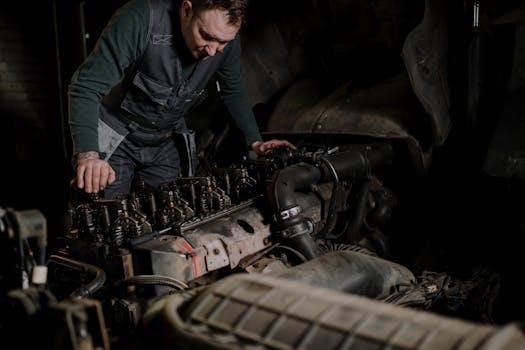Perkins 4 Cylinder Diesel Engine Manual PDF⁚ A Comprehensive Guide
This comprehensive guide delves into the world of Perkins 4-cylinder diesel engines, offering detailed instructions on their safe and economic operation․ Workshop manuals provide assistance for technicians who service and overhaul the engines, ensuring optimal performance and longevity․
Perkins 4-cylinder diesel engines are renowned for their reliability and versatility, powering a wide array of applications, including agricultural machinery, industrial equipment, and marine vessels․ These engines are designed for robust performance and fuel efficiency․ Understanding the specific model and its unique characteristics is crucial for effective maintenance and repair․ Perkins offers various 4-cylinder models, each tailored to meet specific power and operational demands․
This guide focuses on providing comprehensive information and resources for servicing and maintaining these engines․ Access to the correct workshop manual is essential for technicians and owners alike․ These manuals contain detailed instructions, diagrams, and specifications necessary for proper diagnostics, repairs, and overhauls․ With the right knowledge and tools, Perkins 4-cylinder diesel engines can deliver years of dependable service․ The manuals cover components like the cylinder head, pistons, crankshaft, and fuel injection systems․
Identifying Your Perkins 4 Cylinder Engine Model
Accurately identifying your Perkins 4-cylinder engine model is the first crucial step in accessing the correct service and repair information․ Perkins manufactures a range of 4-cylinder diesel engines, each with specific design features and maintenance requirements․ Locating the engine model number ensures you’re using the appropriate workshop manual․ The engine model number is typically stamped on a plate or directly onto the engine block․
Common locations include the cylinder block’s top edge, near the fuel injection pump, or on a dedicated identification tag․ Once you’ve located the engine model number, cross-reference it with Perkins’ official documentation or online resources to confirm the exact model․ Knowing your engine model unlocks access to detailed specifications, torque settings, wiring diagrams, and troubleshooting guides specific to your engine․ Using the wrong manual can lead to incorrect repairs and potential engine damage․
Locating the Engine Number
The engine number is a unique identifier for your Perkins 4-cylinder diesel engine, vital for ordering parts, accessing service records, and ensuring compatibility with specific manuals․ Finding the engine number typically involves inspecting the cylinder block․ Look for a stamped marking on the top edge of the block, often near where the fuel injection pump is mounted․
Alternatively, check for a metal plate or sticker attached to the engine, which may contain the engine number and other identifying information․ In some cases, the engine number might be etched directly onto the block’s surface․ The exact location can vary slightly depending on the engine model and year of manufacture․ Consult your engine’s operation and maintenance manual or the workshop manual for a diagram illustrating the precise location․ Once located, record the engine number accurately․

Workshop Manuals⁚ Overview
Workshop manuals offer assistance in servicing and overhauling Perkins 4-cylinder diesel engines․ They provide detailed instructions for technicians, assuming a level of expertise in engine repair procedures and component knowledge․
Purpose of the Workshop Manual
The primary purpose of a Perkins 4-cylinder diesel engine workshop manual is to furnish technicians and mechanics with comprehensive guidance for the effective servicing, repair, and overhaul of these engines․ These manuals contain detailed step-by-step instructions, exploded diagrams, and technical specifications essential for performing various maintenance and repair tasks․ The manual aims to ensure that repairs are conducted accurately and safely, adhering to the manufacturer’s standards․
Furthermore, the workshop manual assists in diagnosing engine problems, identifying faulty components, and implementing appropriate solutions․ It serves as a valuable resource for both experienced professionals and those new to working on Perkins engines, promoting efficient troubleshooting and minimizing downtime․ By providing clear and concise information, the manual enhances the overall quality of engine maintenance and repair, contributing to the engine’s longevity and reliable performance․ It facilitates proper procedures, preventing further damage and ensuring optimal functionality․
Key Components Covered in the Manual
A comprehensive Perkins 4-cylinder diesel engine workshop manual typically covers a wide array of key components, ensuring technicians have the necessary information for thorough servicing and repairs․ These manuals delve into the intricacies of the cylinder head, providing detailed instructions for valve adjustments, gasket replacements, and overall head maintenance․ Piston and crankshaft repair procedures are also extensively covered, including guidance on bearing replacement and crankshaft alignment․
Furthermore, the fuel injection system receives significant attention, with sections dedicated to injector servicing, fuel pump calibration, and troubleshooting fuel-related issues․ The manual also addresses the cooling system, outlining procedures for radiator maintenance, thermostat replacement, and coolant flushing․ Lubrication system components, such as oil pumps and filters, are thoroughly examined, ensuring proper lubrication practices․ Finally, the manual includes information on the engine’s electrical system, covering starter motor repairs, alternator servicing, and wiring diagrams, offering a holistic approach to engine maintenance․
Accessing and Downloading PDF Manuals
Accessing Perkins 4-cylinder diesel engine manuals in PDF format has become increasingly convenient in the digital age․ Many online platforms offer a wide selection of repair manuals, including car workshop manuals and DIY service guides․ Some websites provide direct links to download Operation and Maintenance Manuals (OMMs) for Perkins engines, offering all the necessary information to keep your engine running smoothly․
For older engines or specific models, you might find scanned versions of original manuals available on enthusiast forums or specialized online stores․ Websites dedicated to providing manuals often have search functions to find your specific engine model․ Always ensure the source is reputable to avoid downloading corrupted or incomplete files․ Once downloaded, these PDF manuals can be easily stored on your computer, tablet, or smartphone for quick access during maintenance or repair tasks․ Some manuals are also available through the Perkins My Engine App․

Operation and Maintenance Manuals
Operation and Maintenance Manuals (OMMs) are vital resources for Perkins engine owners․ They provide essential information to keep your engine running smoothly․ These manuals detail maintenance schedules and troubleshooting common issues for optimal engine performance․
Importance of Regular Maintenance
Regular maintenance is crucial for ensuring the longevity and reliable performance of your Perkins 4-cylinder diesel engine․ Adhering to a consistent maintenance schedule, as outlined in the operation and maintenance manuals, can prevent costly repairs and downtime․ These manuals provide all the information you need to keep your engine in top condition․ Proper maintenance helps optimize fuel efficiency, reducing operational costs and minimizing environmental impact․
Neglecting regular maintenance can lead to a variety of issues, including decreased performance, increased fuel consumption, and potential engine damage․ By following the recommended maintenance procedures, you can identify and address potential problems before they escalate into major breakdowns․ Furthermore, regular servicing ensures that your engine operates within its design parameters, maximizing its lifespan and maintaining its resale value․
Access to operation and maintenance manuals allows owners and technicians to stay informed about the specific maintenance requirements of their Perkins 4-cylinder diesel engine․ This proactive approach to engine care contributes to its overall reliability and efficiency, making regular maintenance an indispensable aspect of engine ownership․
Maintenance Schedules and Procedures
Perkins 4-cylinder diesel engines require adherence to specific maintenance schedules and procedures to ensure optimal performance and longevity․ Operation and maintenance manuals (OMMs) provide detailed schedules outlining the frequency of various maintenance tasks․ These tasks include oil changes, filter replacements, coolant checks, and inspection of belts and hoses․ Following these schedules is critical for preventing premature wear and potential engine failure․
The manuals also describe the correct procedures for performing each maintenance task․ These procedures often include step-by-step instructions, accompanied by diagrams or illustrations, to guide users through the process․ Proper execution of these procedures is essential to avoid causing damage to the engine or its components․ Additionally, the manuals specify the recommended lubricants, coolants, and other fluids to use, ensuring compatibility and optimal performance․
By diligently following the maintenance schedules and procedures outlined in the OMM, owners and technicians can maintain their Perkins 4-cylinder diesel engines in excellent condition, maximizing their lifespan and minimizing the risk of costly repairs․ Regularly checking and servicing engine components will ultimately contribute to more efficient and reliable operation․
Troubleshooting Common Issues
Perkins 4-cylinder diesel engines, while robust, can experience common issues․ Operation and Maintenance Manuals (OMMs) are invaluable resources for diagnosing and resolving these problems․ These manuals often include troubleshooting charts that guide users through a systematic process of identifying potential causes based on observed symptoms․
Common issues addressed in the manuals include starting problems, such as difficulty cranking or failure to start altogether․ The troubleshooting section might cover checks for fuel supply, battery condition, and ignition system components․ Overheating is another frequent concern, with potential causes ranging from low coolant levels to a faulty thermostat․
Reduced power or poor performance is also a typical issue, and the manual can help identify problems with the fuel injection system, air intake, or exhaust system․ Unusual noises, such as knocking or hissing, are addressed, with guidance on identifying the source of the noise and potential remedies․ By following the troubleshooting steps outlined in the OMM, users can often resolve minor issues themselves, saving time and money on professional repairs․ However, more complex problems may require the expertise of a qualified technician․

Servicing and Repairing
This section covers servicing and repairing Perkins 4-cylinder diesel engines, using workshop manuals․ These manuals provide detailed instructions for engine component repairs like the cylinder head, pistons, crankshaft, and fuel systems․
Cylinder Head Servicing
Cylinder head servicing is a critical aspect of maintaining a Perkins 4-cylinder diesel engine․ The workshop manual offers comprehensive guidance on disassembling, inspecting, and reassembling the cylinder head․ It details procedures for valve grinding, seat replacement, and checking valve clearances․ Proper cylinder head maintenance ensures optimal engine compression and combustion efficiency․
The manual also covers inspecting for cracks, warpage, and other damage, offering precise measurements and tolerances․ Detailed diagrams and illustrations aid in understanding the cylinder head’s complex components and their functions․ Torque specifications for head bolts are provided to ensure proper sealing and prevent leaks․
Following the workshop manual’s instructions guarantees that cylinder head servicing is performed accurately, extending the engine’s life․ This includes lubricating rocker assemblies with engine oil after reassembly․ Regular servicing prevents costly repairs and maintains peak engine performance․ Properly serviced cylinder heads contribute significantly to the overall reliability of Perkins diesel engines․
Piston and Crankshaft Repair
Piston and crankshaft repair is a crucial part of Perkins 4-cylinder diesel engine maintenance․ The workshop manual provides detailed procedures for inspecting, repairing, and replacing pistons and crankshaft components․ This includes checking piston rings for wear, inspecting cylinder bores for damage, and measuring crankshaft journals for proper tolerances․
The manual offers step-by-step guidance on removing and installing pistons, connecting rods, and the crankshaft itself․ It specifies the correct torque settings for connecting rod bolts and main bearing caps to ensure proper assembly․ Detailed illustrations and diagrams clarify the process, making it easier to follow․
Proper piston and crankshaft repair maintains engine balance and reduces vibrations․ It also prevents oil leaks and ensures efficient combustion․ Ignoring wear or damage to these components can lead to severe engine damage and costly repairs․ Following the workshop manual’s instructions guarantees that piston and crankshaft repairs are performed accurately, extending the engine’s life․
Fuel Injection System Maintenance
Maintaining the fuel injection system in a Perkins 4-cylinder diesel engine is vital for optimal performance․ The workshop manual provides specific procedures for inspecting, cleaning, and repairing fuel injectors, fuel pumps, and fuel lines․ Proper maintenance ensures efficient fuel delivery, reduces emissions, and prevents engine knocking․
The manual details how to diagnose common fuel injection problems, such as clogged injectors or a faulty fuel pump․ It includes instructions for testing injector spray patterns and fuel pump pressure․ Detailed diagrams and illustrations aid in understanding the system’s components and their functions․
Regular fuel filter replacement is crucial to prevent contaminants from damaging the fuel injection system․ The manual outlines the recommended fuel filter change intervals; Additionally, it provides guidance on bleeding the fuel system after filter replacement or fuel line repairs․ Following these maintenance steps ensures the fuel injection system operates efficiently, contributing to the engine’s reliability and fuel economy․

